
A Visit with Upcycle Hawaii to One of the Most Plastic Polluted Beaches in the World
Remember that artist, Mattie Mae Larson of Upcycle Hawaii, that I told you was living my dream in Hawaii!? Well, I never would’ve imagined when writing that post, that one year later, I would actually have the opportunity to travel to the Big Island to meet her (and Pua!) to get a glimpse into her business, Upcycle Hawaii, and her tireless efforts to help our planet.
This post may contain affiliate links and we may earn compensation when you click on the links at no additional cost to you.

Mattie Mae and Pua of Upcycle Hawaii.
During my time with Mattie Mae, we travelled to the front lines of one of the most plastic polluted shorelines in the world, where she frequently gathers portions of ghost nets for her upcycled products and routinely participates in beach clean-ups.
We also visited Mattie Mae’s studio in Hilo, where she is always hard at work upcycling materials and designing innovative, one-of-a-kind products (click here to read about our visit to Upcycle Hawaii).

I’m grateful to be able to take you down to the remote, rugged, shoreline to get a closer look at the fight against plastic pollution and Mattie Mae’s truly incredible efforts to help our planet.
You can help make a difference! Donate to Upcycle Hawaii (through GoFundMe) to help their business grow and further spread their mission!
Coastline
Our day began early in the morning, when Mattie Mae picked me up from the airport in Hilo and we immediately began the hours’ long journey to the remote shoreline.
The drive to get to one of the most plastic polluted coastlines in the world was quite an adventure for many reasons. First of all, the untamed beauty of the area is simply breathtaking! It’s easy to see why this is one of Mattie Mae’s favorite places to disconnect from the world and recharge.

Untouched beauty.
The last portion of the drive was extremely bumpy and rugged. Dips in the pathway, large rocks, winding paths and branches scratching the vehicle along the way, made for quite a difficult drive. Not to mention the heat, and at times, the wind coming off the ocean and kicking up dust. Definitely, nothing easy about this journey… which makes the fact that Mattie Mae frequently travels it, even more remarkable.

The mighty Pacific Ocean meeting the shores of Hawaii.
Once at the water’s edge, you can certainly see- and feel- the power of nature. The sights and sounds of enormous waves hitting land for the first time after travelling across the Pacific Ocean was unbelievable.
The area is very isolated and there isn’t a sign of civilization anywhere… that is, until you look down at your feet.
Staring out at the ocean, it hadn’t yet occurred to me that we were walking through bits of plastic marine debris, of all shapes and sizes.
You can help make a difference! Donate to Upcycle Hawaii (through GoFundMe) to help their business grow and further spread their mission!
Because the Big Island is the eastern most Hawaiian island, incoming winds and ocean currents meet its shores first after traveling uninterrupted in the open ocean. It is also relatively close to the Great Pacific Garbage Patch and acts as a sifter which removes whatever items might be floating in the waves.
Plastic debris was scattered everywhere along the shoreline where we were standing. Seeing the marine debris in person is quite a difficult thing to process. Here, in the middle of the Pacific Ocean, in an isolated area far from human activity, lay evidence of the enormous impact plastic is having on our planet. Right there, before our eyes, and indisputable. (Up-close photos below.)
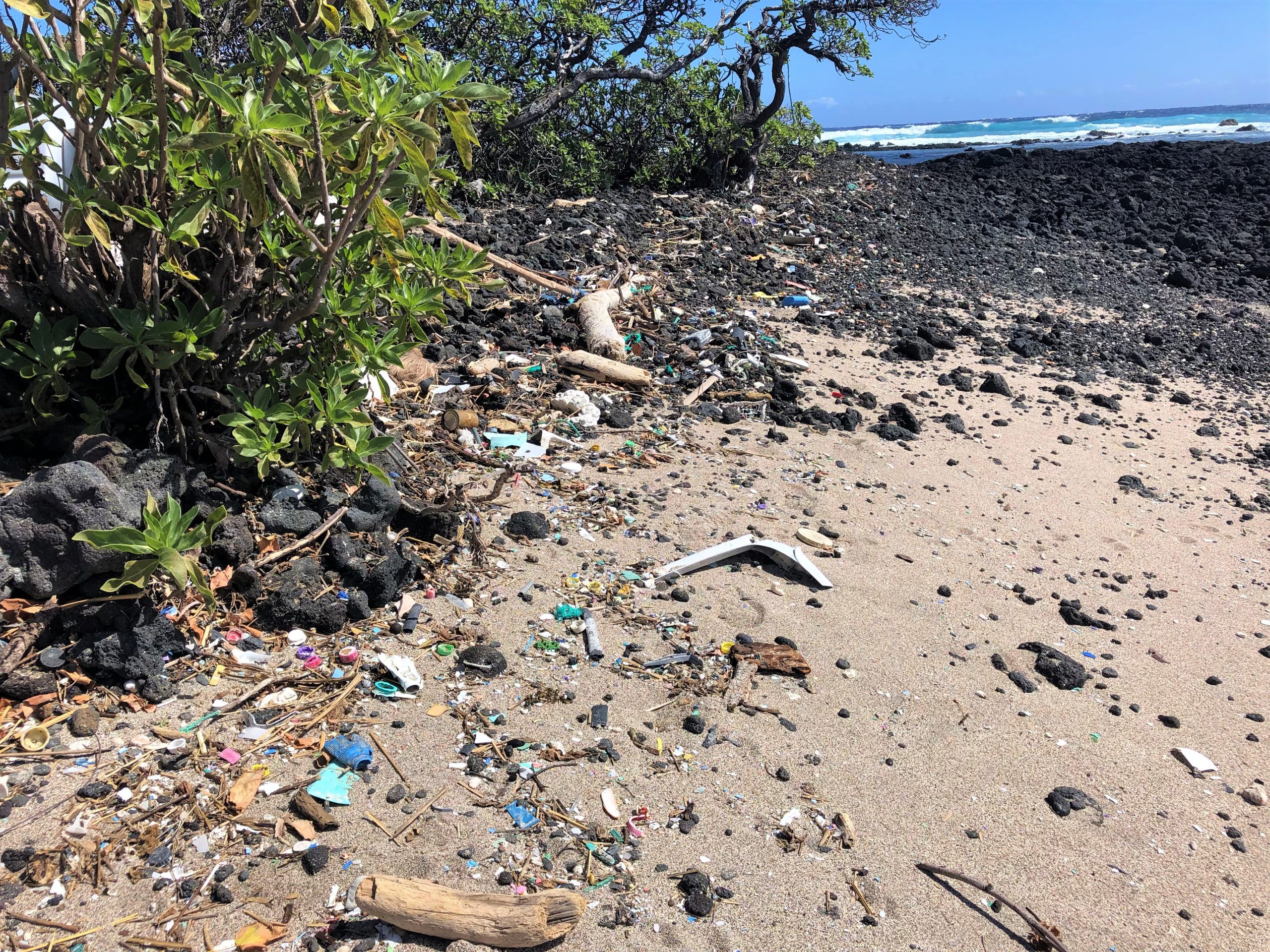
Bits of plastic litter the shoreline.
Not far from us, baking in the sun was a huge, teal ghost net, a dangerous, frequent item found along Hawaii’s shores and one of the items Mattie Mae upcycles in her studio.
What is a Ghost Net?
Ropes and nets lost or discarded by fishing vessels out at sea, are referred to as ghost nets. As they drift through the ocean they “ghost fish” and continue killing marine life and destroying fragile coral reefs, as they are pulled through the currents. Because the synthetic materials used to make fishing gear doesn’t break down, items lost at sea can cause damage for decades.

Washed up ghost net.
Depending on their size, ghost nets can weigh a couple hundred pounds and removing them from the beach is no easy task as they are snarly and heavy. Ghost nets often cost thousands of dollars when originally purchased, however, washed ashore have zero value and are costly in time, money and resources to remove and dispose of.
Mattie Mae is able to cut and use sections of ghost nets that are in good condition, to create items of value in her upcycled, melted marine debris products at Upcycle Hawaii.
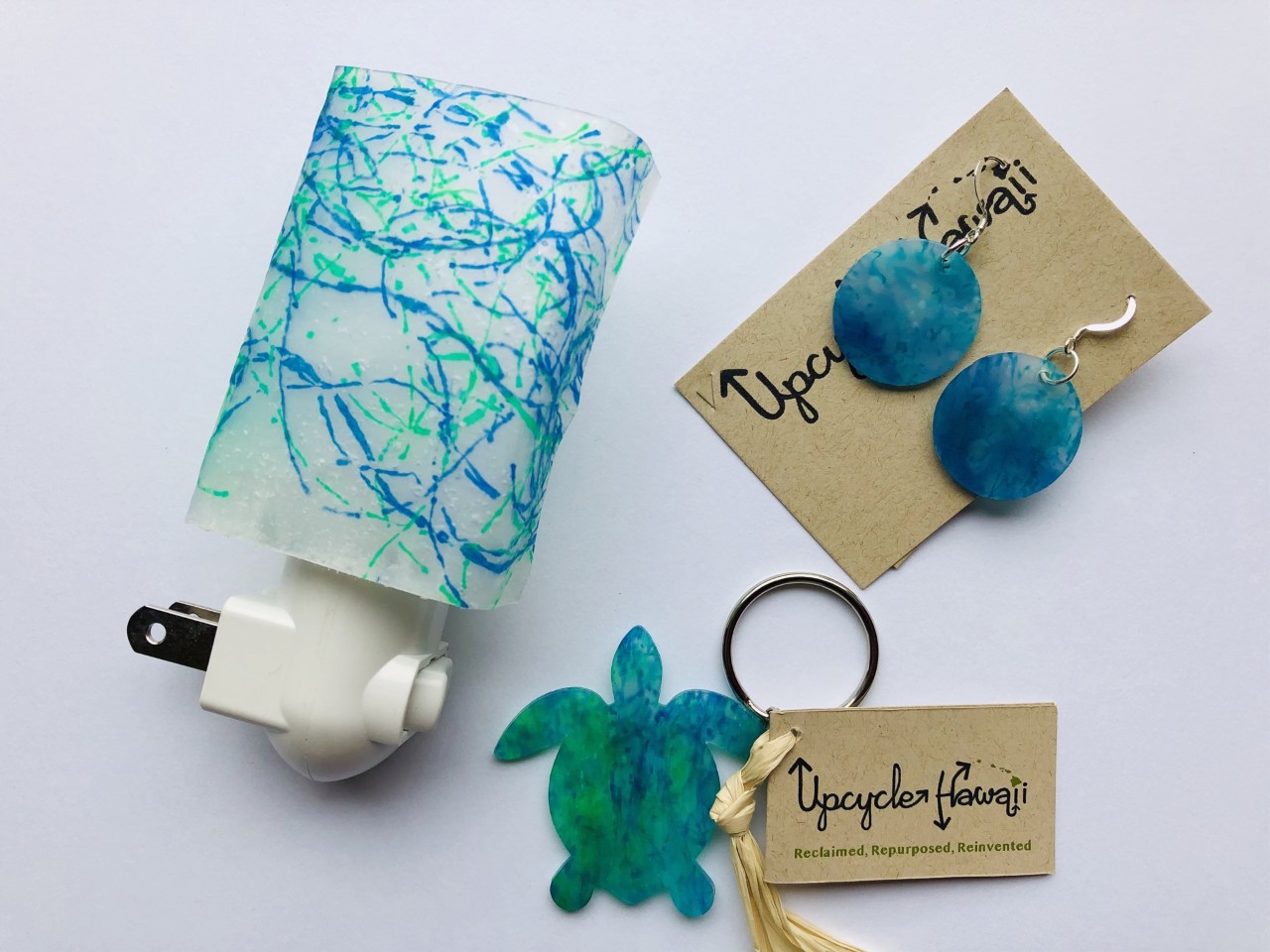
Melted marine debris items from my growing Upcycle Hawaii collection!
While looking at the ghost net, Mattie Mae pointed out a material known as Plastiglomerate, which is formed when plastic burns or melts and fuses to rock and/or other organic materials it comes in contact with. It is a permanent, geologic record of plastic pollution. Crazy!

Plasticglomerate, melted plastic fused to rock.
Before moving on to another section of the shoreline, Mattie Mae made note of the location and approximate size of the net. In addition to running Upcycle Hawaii, she is currently the Big Island’s Arts and Cleanup Coordinator for Hawaii Wildlife Fund, a local, non-profit organization that performs beach cleanups with the help of volunteers from the community.
Hawaii Wildlife Fund is able to remove ghost nets (and other marine debris) with the proper equipment/permits needed and the information regarding this net will be relayed, so its removal can be scheduled into an upcoming beach clean-up event.
Plastic as Far as the Eyes Can See
Further down the coast, we stopped at an area once frequented by the ancient Hawaiians. Massive timbers of driftwood, that had washed ashore, would be gathered from the area and used to make large, sea-faring vessels.
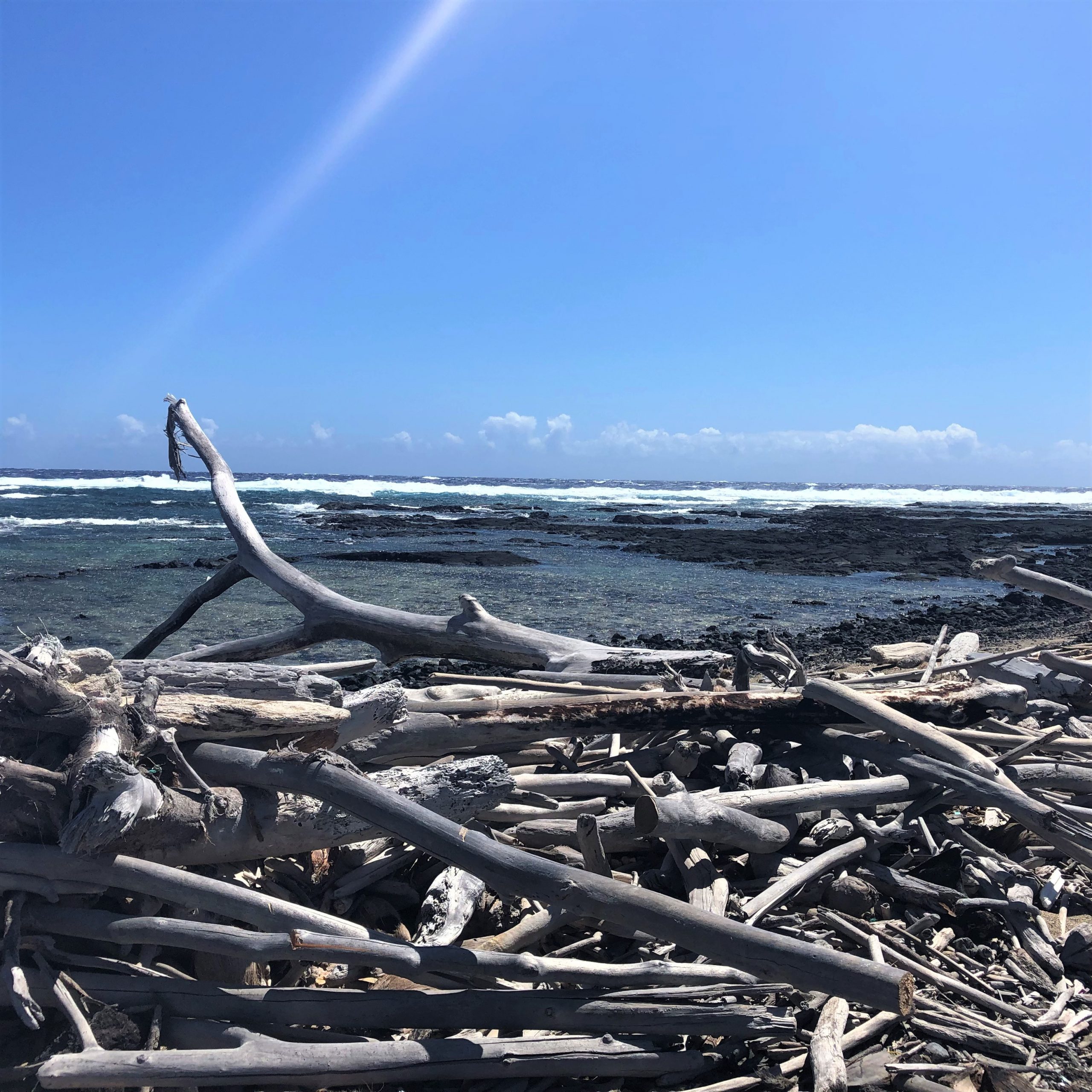
Look at that view!
Today, driftwood can still be found lining the shores, however, it contains layers and layers of plastic debris woven into the rock and wood.
You can help make a difference! Donate to Upcycle Hawaii (through GoFundMe) to help their business grow and further spread their mission!
On the surface lay tons of familiar, plastic items, to include: combs, hangers, toothbrushes, bottles, pieces of kids’ toys (trucks & building blocks), and thousands of bottle caps. Broken bits of plastic, in all shapes, sizes and colors were mixed throughout the timbers, and were all that remained of a once intact item.

A mix of driftwood, rock and plastic.
We passed hundreds of hard, 8 inch plastic “straws,” which Mattie Mae told me were actually spacers used by the oyster farming industry. Because oyster farming is done in the ocean, many of these items are washed out to sea as a result of weather, ocean conditions and/or human error.

Plastic oyster spacer.
Speaking of ocean/weather conditions, the wind and waves are so strong along this section of coastline, that debris can often be found tangled up in the vegetation. The lightweight, plastic marine debris is no match for a strong tropical breeze and it is easily blown into the surrounding trees and plants.

A rope spotted in the plants.
On another section of sandy beach, there was plastic scattered about, as far as the eye could see. Despite that, Mattie Mae told me it was actually “clean” for this section of coastline. As a child, she remembers coming to this area and climbing piles of plastic trash, several feet deep, in a game she called “King of the Plastic Hill.”
Thankfully, due to ongoing cleanup efforts, the massive piles of plastic marine debris are no longer standing, however, huge amounts of plastics continue to wash ashore daily.
The first thing that strikes you, is the amount of large objects… lawn chairs, crates, jugs, fishing ropes, barrels, and big pieces of unidentifiable plastics.
It was clear these items had been floating in the open ocean for months. The intense sun and currents had taken their toll on the plastics and they were very worn and faded. Many items even had marine species attached to them, which are often invasive to the unique ecosystems of the Hawaiian Islands (see photo of yellow bin below).
Sadly, it appeared the invasive species were actually far outnumbered by another destructive intruder… microplastics.
Plastic items floating at sea, are broken down, over time, by weather and the churning of the ocean waters. The breakdown of plastic material results in microplastics, small pieces of plastic (5 mm or less) that float at the surface of the ocean and are washed ashore with the waves.
As microplastics float in the hot sun, on the open ocean, they leach toxic chemicals into the water and often end up being accidently consumed by marine life. Obviously, this isn’t healthy for the creatures, or their environment, and the problems only continue when the microplastics reach land.
Without a doubt, microplastics were the most numerous item we saw on the beach and arguably, the most difficult to remove from the environment.

Microplastics galore.
In addition to leaching chemicals and being consumed by creatures, microplastics cover the beaches used by native, often endangered, wildlife for nesting and basking. These natural activities can become harmful when the sand is literally full of thousands of pieces of sharp plastic.
The Hawaiian Monk Seal is endemic to Hawaii and is one of the most endangered species in the world. Currently, there are only around 1,400 left in the wild, and about 300 of those frequent the main Hawaiian Islands, including this stretch of shoreline, to give birth and raise their young. (Imagine your baby’s nursery full of litter.)

Endangered Hawaiian Monk Seal, off the coast of Maui.
Beaches and waters, free of microplastics, marine debris and deadly ghost nets that entangle creatures are critical to the health and survival of Hawaiian Monk Seals, other endangered species, and native wildlife.
You can help make a difference! Donate to Upcycle Hawaii (through GoFundMe) to help their business grow and further spread their mission!
Single-Use Plastics Galore
Coming in a close second to the amount of microplastics we encountered were single-use plastic items, including toothbrushes, silverware, beverage bottles, and thousands of bottle caps and lids from all over the world.
Many of the beverage related items, had the same, familiar, global companies printed upon them, and they could even be found in several languages.
There are so many single-use plastics washing ashore along this section of coastline, that survey zones have been set up by a local organization to document the number of each item found within the marked area(s) during each beach cleanup.
The data gathered from the survey zone(s) is critical in getting laws passed that help prevent further plastic pollution from entering the ocean. It simply isn’t enough for an organization to say “we see a lot of ‘this item’ wash ashore,” as lawmakers need to see actual totals, over a period of time, that reflect what is actually happening.
Because of the amount of debris that must be disposed of following an organized beach cleanup in this area (we are talking hundreds of pounds each time), organizations and individuals must adhere to the county rules and regulations for doing so.
Thankfully, Mattie Mae, and other volunteers, will return to this shoreline soon for an organized cleanup effort, to continue the tireless work of removing marine debris from its remote beaches.

Plastic covering the sand.
Before leaving the coast, Mattie Mae took us back to the very first location we had stopped at, the one with the massive teal ghost net, to say our goodbyes to the area.
After a few hours spent looking at the ground and trampling through hoards of plastic marine debris, it was extremely overwhelming to see the impact pollution is having on our environment. Not an easy thing to face or process and the last few moments at the beach were pretty heavy and honestly, left me feeling helpless.

On a mission to help the earth.
Mother Nature came to my rescue though, and within a few moments of standing there, I again found myself in awe at her beauty. Seeing the mighty waves crash upon the black rocks and the untamed beauty, left me feeling calmed and inspired, just as it had at the start of the day.
We owe it to Mother Nature to return the favor and come to her rescue whenever we can, by cleaning up our own communities and beaches, making earth friendly decisions in our daily lives, supporting those involved with cleanup efforts and kindly sharing with others what we’ve learned, and seen, about pollution.

The pen cap that washed ashore as we were leaving.
Just before hopping in the truck to begin the journey home, Mattie Mae spotted an item in the water, a few feet from us, drifting towards shore. (Her eyesight is insanely remarkable!)
Almost, right on cue a black pen cap was reaching land, likely for the first time in years…. a reminder for this blog writer of a quote from my favorite book…
“It is not often that someone comes along who is a true friend and a good writer. ~ Charlotte’s Web, by E.B. White
I hope by sharing this story, I have been both for our planet.
Help Make a Difference
Are you inspired after reading about Mattie Mae’s efforts to make a difference with marine debris, and post-consumer waste? Do you want to get involved and help Upcycle Hawaii further their mission, grow their business and continue the fight against plastic pollution?
Check out the ways we’ve listed below that you can help Upcycle Hawaii make a difference!

Refuse, Reduce, Reuse, Repurpose, Recycle
One of the most important things you can do to help fight plastic pollution is to remember to Refuse, Reduce, Reuse, Repurpose, Recycle.
- REFUSE: Refuse to use or purchase items that are not environmentally friendly.
- REDUCE: Reduce the amount of plastic items you use and/or purchase.
- REUSE: Make the switch to reusable alternatives from single-use plastics. Swap out everyday items such as straws, cutlery, shopping bags, sandwich bags and water bottles with earth-friendly, reusable options. (We love our silicone sandwich bags and drinkware!)
- REPURPOSE: Come up with new ways of using existing plastic items or ways to turn them into something new.
- RECYCLE: When all else fails, recycle plastic and other materials.
Donate Materials
If you live on the Big Island and would like to donate *materials to Upcycle Hawaii, please visit their donations page for more information and details about what items are accepted. Studio drop-off hours vary and items must be CLEAN and DRY before donating.
*Upcycle Hawaii accepts donations, from their community, of plastic packing from a variety of everyday household items, including bread, tortillas, toilet paper, paper towels and diapers.
Shop Upcycle Hawaii
If you live on the Big Island, O’ahu or Kaua’i, or are planning on visiting, you can find Upcycle Hawaii’s products at several, locally owned businesses including:
- Big Island
- The Lacavore Store (Hilo)
- Island Naturals (Hilo)
- Basically Books (Hilo)
- Puna Chocolate Company (Hilo/Kona)
- Pueo Boutique (Kona)
- Kona Bay Books (Kona)
- Aesthetic Gallery (Waikoloa)
- Dolphin Quest (Waikoloa)
- Elements (Hawi)
- The Volcano House (Volcano)
- Volcano Garden Arts (Volcano)
- O’ahu
- Magnolia (Kahala Mall)
- Homegrown (Pearlridge)
- Global Village (Kailua)
- Dolphin Quest
- Kaua’i
- Island Soap & Candleworks (Koloa)
Upcycle Hawaii also offers online shopping where you can purchase their unique, upcycled, handmade-in-Hawaii products.
Donate Funds
Make a donation to Upcycle Hawaii (through GoFundMe) to help their business grow and further spread their mission!
Donations will go directly toward manufacturing supplies and employee wages and will also indirectly grow product sales and help to divert materials from the landfill.
Show Your Support on Social Media
You can connect with Upcycle Hawaii on Instagram, Facebook and Mattie Mae’s blog.
I have enjoyed learning and following Upcycle Hawaii on their journey to reduce waste and educate the public on marine debris. I highly recommend you take a look too… you are sure to be inspired and amazed!
Mahalo Mattie Mae
An enormous thank you to Mattie Mae Larson for taking the time to share with me your community, island home, efforts against plastic pollution, and your creativity at Upcycle Hawaii’s studio to divert post-consumer waste from the local landfills.

Your warm personality, kind smile, positive outlook, endurance, work ethic, humility in service and genuine concern for others and the environment are a true inspiration (to name a few, lol). The world needs more neighbors like you!
Thank you also to Pua for joining us and allowing me to share the passenger seat with you!
Read about our other Hawaiian adventures:
Maui
- Volunteering at O’o Organic Farm
- Maui Ocean Center, Aquarium
- Stargazing at Haleakala National Park
- Best Snorkeling in Maui ~ Molokini Crater & Turtle Arches Cruise with Pacific Whale Foundation
- The Best Luau in Maui ~ The ‘Aha’aina Wailea Luau, at Grand Wailea Resort
- Maui Humane Society, Beach Buddies Program ~ Volunteer on Vacation
Big Island
- Hilo Tropical Waterfall Tour with Hawaii Forest and Trail
- Kona House Condo
- Giving Back on Vacation: Hawai’i Wildlife Center
- Meet the Artist; Mattie Mae Larson of Upcycle Hawaii (Big Island, plastic pollution, marine debris, unique wearable art.)
- Upcycle Hawaii ~ A Peek Inside their Studio
- One Aloha Organic Shave Ice
Also be sure to check out our Top 30 Gift Ideas for Travelers. It is full of unique gift ideas for those in your life who love to travel… or to add to your own personal carry-on. We’ve even included the one item we won’t go to Disney without! It might surprise you!


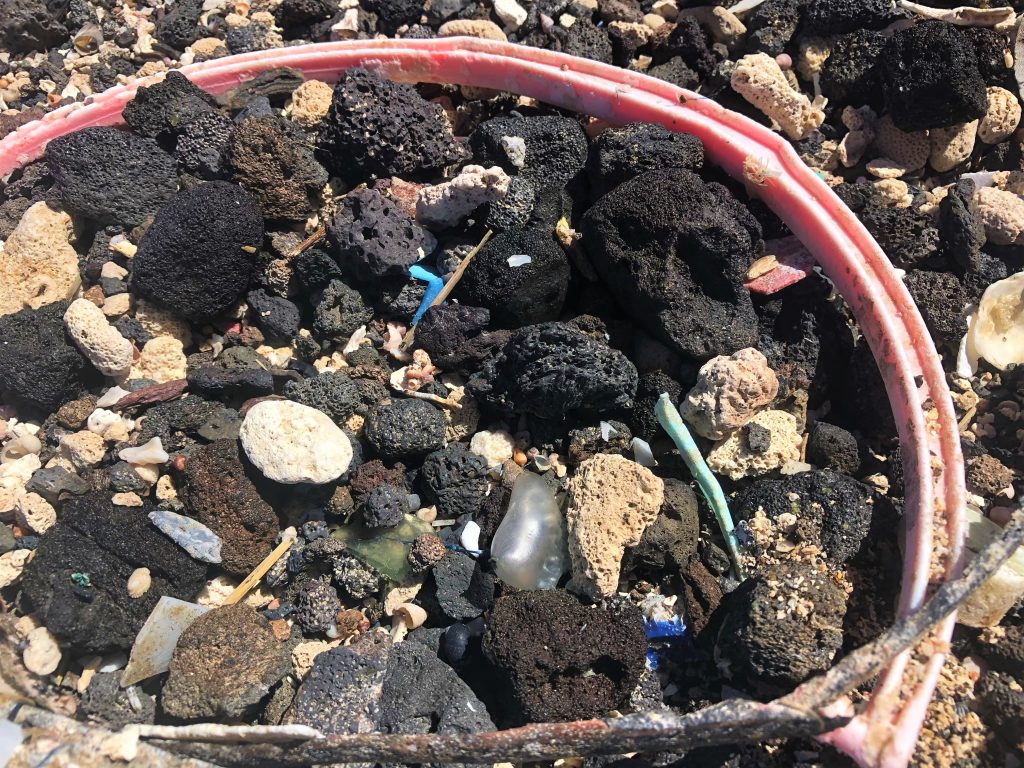





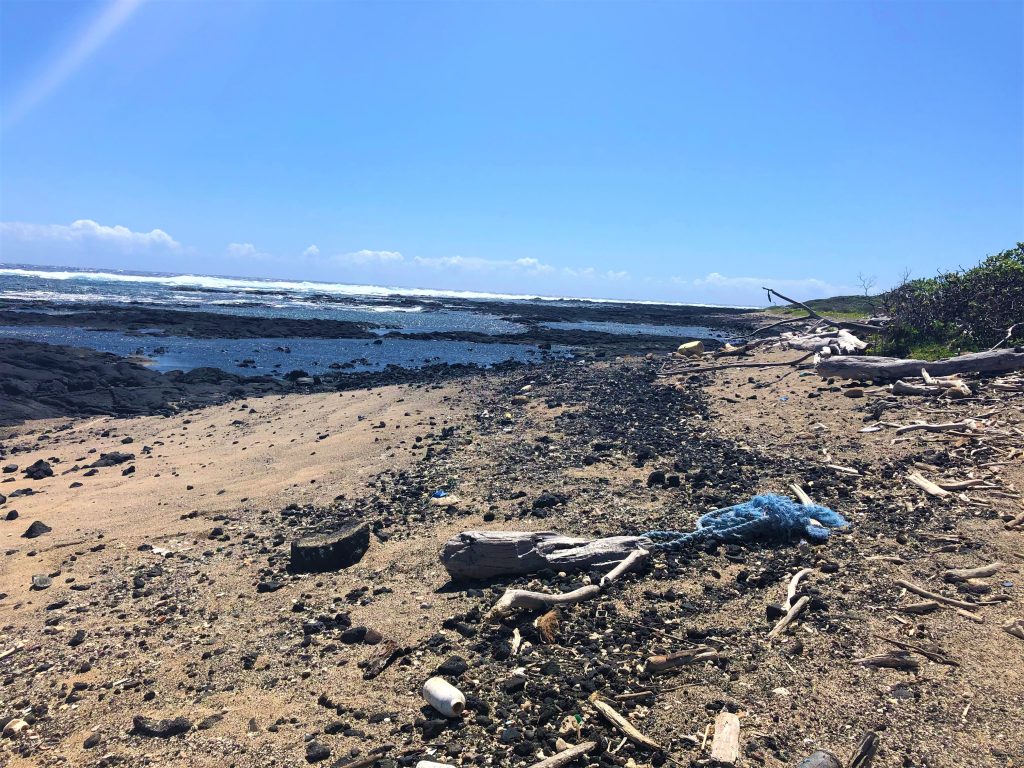



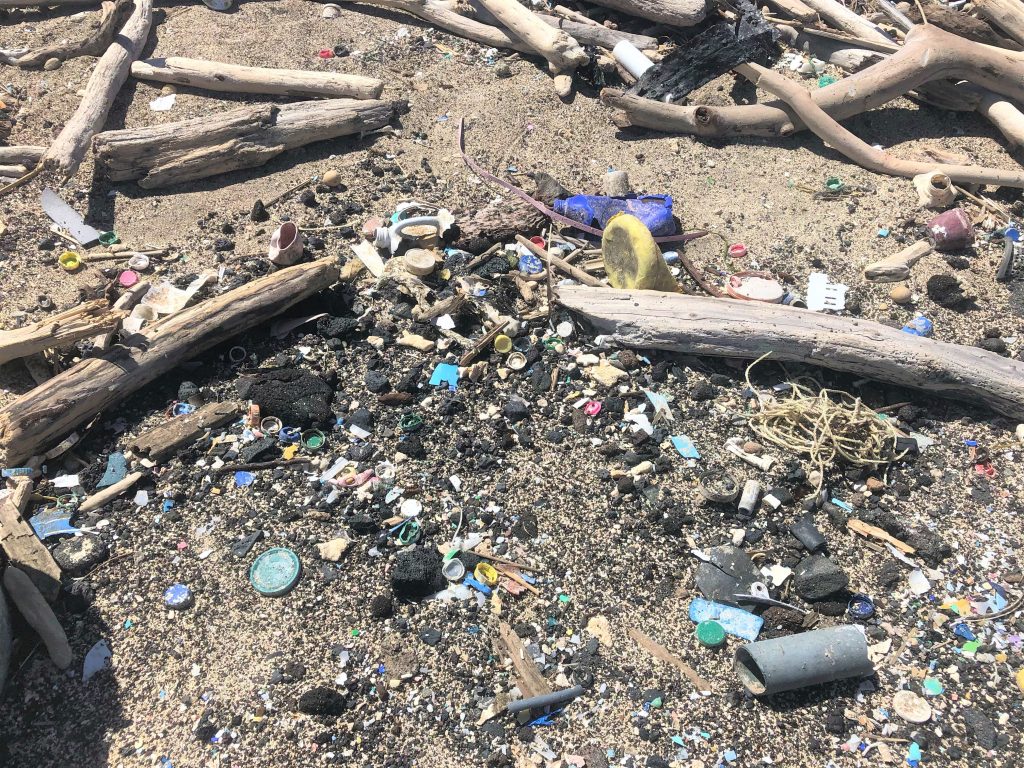

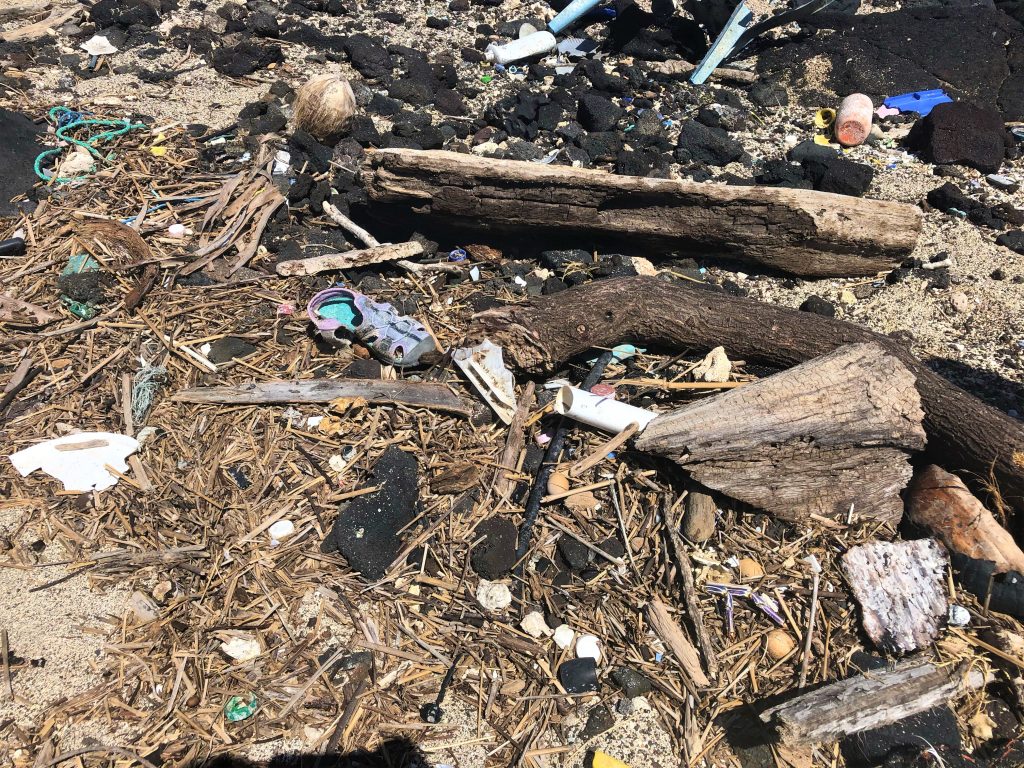


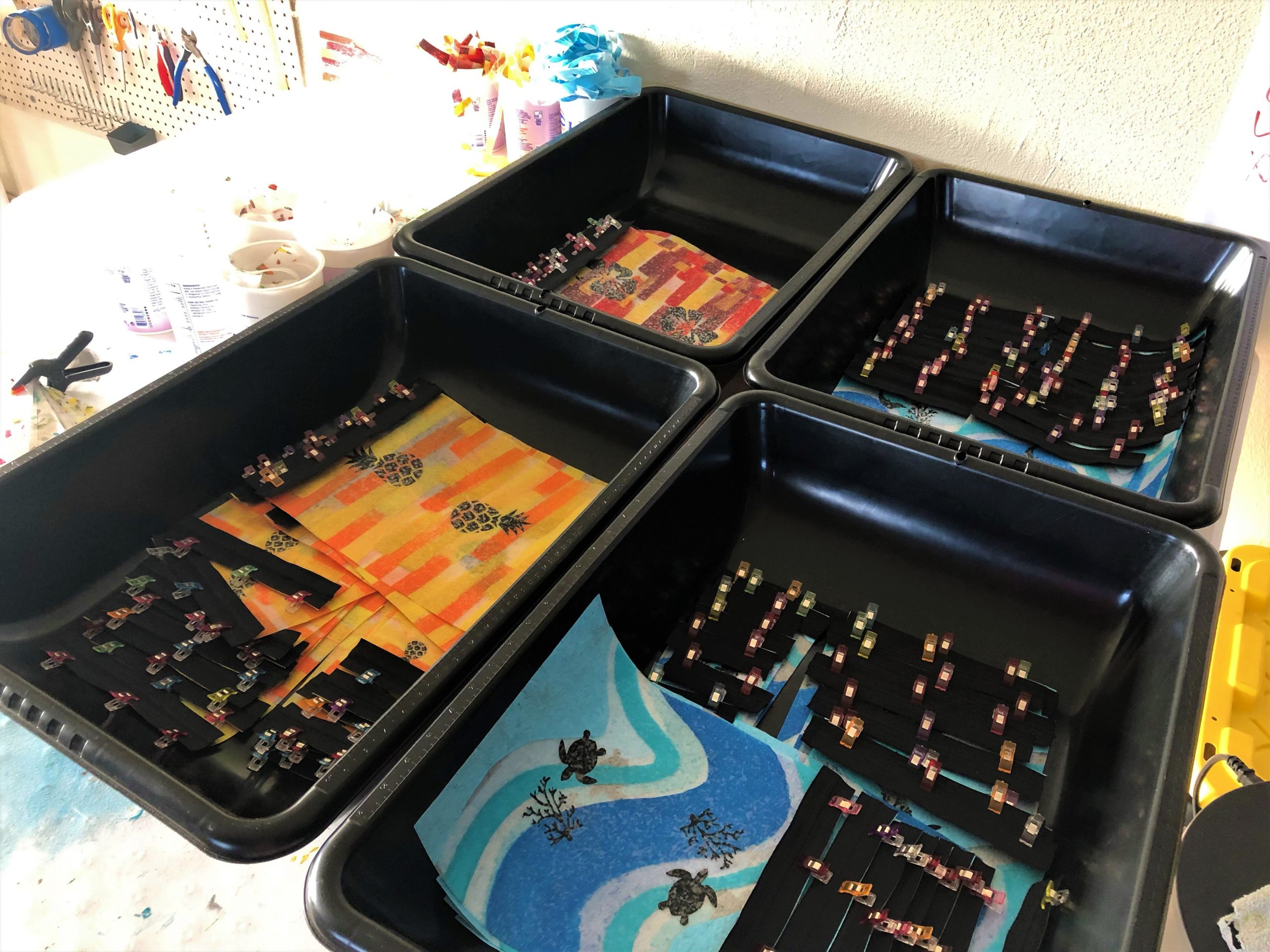


30 Comments
Pam
Wow – this is so interesting. Your pictures really bring to life how much washes ashore. I love the mission and products from Upcycle Hawaii.
Charlene
Aw… we do too! Such beautiful handmade products with an awesome story and purpose behind them. The beach was very difficult to see and there was plastic everywhere. So glad Upcycle Hawaii is making such a difference for our planet.
Casandra
It’s such a shame how much single use plastic pollution is in that area alone. I try and do my part to prevent this by refusing to buy them. What an amazing service Upcycle Hawaii is doing.
Charlene
Keep up the great work doing your part to help the planet! LOVE IT! I cannot say enough good things about Upcycle Hawaii!
Taquia
I really admire Mattie Mae’s efforts. It was surprising reading about what you found on the shoreline. Thank for sharing your experience.
Charlene
Mattie Mae is definitely someone who is going to keep fighting to make our earth a cleaner place. I’m so grateful to have had this experience. I am also so thankful Upcycle Hawaii is going above and beyond to divert materials from the local landfill and to raise awareness about marine debris.
Eva Keller
What a great cause! It’s amazing how much trash can wash up into one spot and that it can last so long. It’s a shame that it ruins so much of a coastline that many would be able to enjoy otherwise.
Charlene
Upcycle Hawaii is AHHMAZING! Such dedication and hard work! It was really eye-opening to see this plastic pollution situation in person. It is forever cemented into my mind and is my motivation for doing what I can to cleanup the earth and help prevent pollution like this.
Missy
Cute Monk Seal. It is sad how much trash there is.
Charlene
Sad indeed… thankful there are so many great people volunteering with ongoing cleanup efforts. The Hawaiian Monk Seal was quite a treat to see! I’ve always wanted to see one and still can’t believe it actually happened!
kmf
Wow…what a meaningful experience with purpose. I found your post equally fascinating and disturbing. Thank you for educating us and showing the plastic pollution in real life. So many opportunities to make our world cleaner.
Charlene
I’m so thankful to have had this experience and glad there are dedicated volunteers that are working with ongoing cleanups. It is a great motivation to me to keep making earth-friendly choices…even when I’m overwhelmed and feeling like it’s not making a difference. Every little action adds up to something bigger.
Stacie Yocum
This is devastating. We need to be better and do better as humans. Wow. What an experience.
Charlene
I couldn’t agree more… the earth needs our help.
Lisa Manderino
This is a great post! I try pretty hard to take care of our wonderful earth but this is eye opening!
Charlene
Thank you. It was a very eye-opening experience for me, as well. So glad to hear you are doing what you can to help the earth!
Jennifer
We used to clean up beaches in my youth days. But, it was nothing like this. Her products are lovely that she creates from what she finds.
Charlene
I love how bright and colorful her products are! Definitely a huge transformation from what the materials started out as. Thank you for cleaning up beaches! We frequently cleanup along the shores of Lake Michigan and always find tons of plastic pollution, but nothing like what was on the beaches on the Big Island.
Stacey Billingsley
I’d never heard of Upcycle Hawaii. It’s so cool what they’re able to make using the ghost nets and other items. I’m trying to do better about not using single-use items. This post reminds you why!
Charlene
I discovered Upcycle Hawaii about a year ago, while researching for a trip to the Big Island. I have really enjoyed seeing the work they do, it motivates and inspires me. I LOVE her upcycled ghost net products. Keep up the great work making the switch from single-use plastics.
Jordin
I LOVE the Big Island with so much of its beauty untouched! I would love to participate in the clean up next time I’m on the island. I’m checking out the shop as I like to gift items from my travels.
Charlene
YAY! I really want to help with a cleanup there too! We weren’t able to do any cleaning up that day… just looking. Great idea about gifting items from travels, especially from places very dear to you. The hard part is deciding what to choose! LOVE seeing your Big Island posts and pix too!
heather J jandrue
Oh my goodness. This is crazy. I am so sad for our Earth. I applaud this young lady and all that she is doing. Amazing!
Charlene
Couldn’t agree more! Three cheers for Upcycle Hawaii!!!
Hera
Fantastic organization with purpose and true care for the earth. Next time I’m in Hawaii, I’ll want to visit and partake in the cause
Charlene
It’s pretty awesome what Upcycle Hawaii is doing to help to earth. Love supporting their work!
Jennifer | Me and My Traveling Hat
When I think about the Hawaiian Islands I would never imagine that is was one of the most polluted coasts in the world. It was shocking to see how much debris is on that coast. I like the way you both are bringing an awareness to this problem and making things that are beautiful out of the debris.
Charlene
The Hawaiian Islands are stunning and it is so sad to see the situation they are faced with regarding marine debris washing ashore from around the world. We love Upcycle Hawaii’s innovation with their products and also their passion for educating others about plastic pollution. Love, love, love, them!
Cindy
That is so sad but I love the efforts to clean up and to support those that are local who can do the clean up. We have traveled to some places with similar beaches. Very sad to see wildlife amid the trash.
Charlene
It was truly heartbreaking to see the plastic pollution along the shores. It is a great motivation and reminder to make simple changes at home to help stop the flow of pollution into our seas.